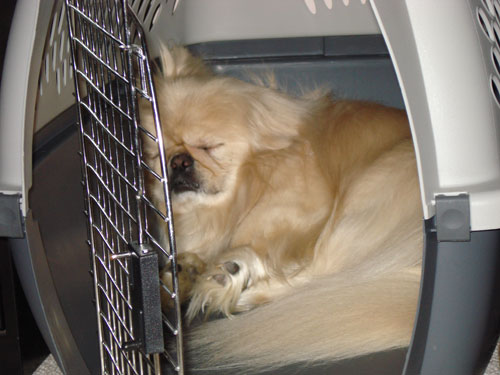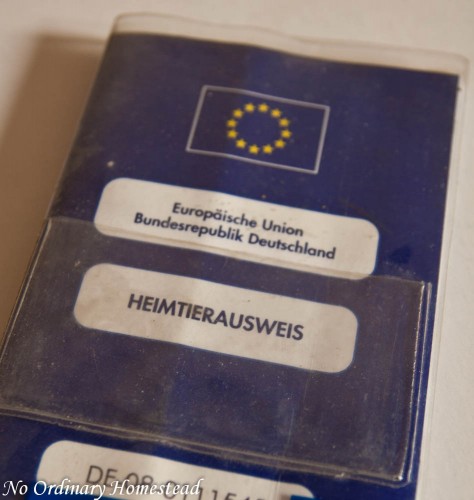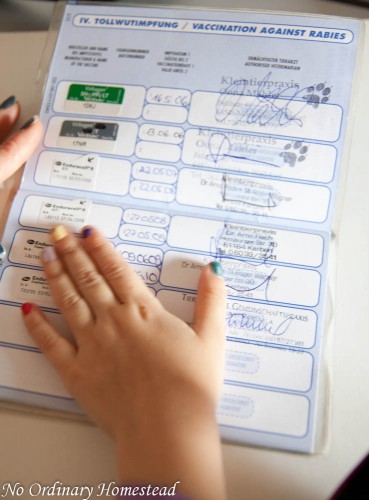Happy Wednesday friends!
And what a cool one it is. Mom asked me to do something super useful today which is talk about moving to Germany with your pets. I’m not actually one of those pets because my ancestors were imported to Germany long before I was ever born. But mom and dad did bring our two cats with them all those years ago when they moved here…for better or worse.
In case you’ve ever wondered, Germany is generally very pet friendly. There are a lot of hotels that allow pets to travel with you and you can even take your pets onto the trains here after buying them a special ticket (which is about half the price of a human ticket). There is a bit of big dog discrimination in some places (like those silly hotels & apartments that only allow small dogs); but I think that’s mostly because so many people haven’t met awesome dogs like myself. In most cases, you can bring your dogs to restaurants, beer gardens, farmers’ markets, parks, many beaches, and so on. But we do have to wait outside for you at grocery stores…which I can only assume is because some dog went a little crazy once in the meat department… 😉
Get Prepared
Thankfully, Germany is not usually one of those countries where you have to put your pets in quarantine for months and months before they are allowed in. But you do have to get a clean bill of health from a veterinarian that certifies that your pets have no infections, diseases or other afflications that could be spread if the animal hops on a plane. And you must be current with your rabies vaccine.
Rabies vaccinations must be up to date, so you may need to get going with this a few months in advance. The shots should not have been administered less than 30 days before the flight date, and within the last 12 months.
It is also required to have your pet microchipped — although some older ones can get away with just having a clearly done tattoo.
According to the BMELV:
The entry conditions mentioned above must be documented by a veterinary certificate. The veterinary certificate must be issued by an official or officially authorised veterinarian. In addition, the traveller must be accompanied by supporting documents such as a vaccination certificate or a document certifying the blood test. Please note that every pet (dogs, cats, ferrets) has their documents and identity checked when entering/re-entering the EU from a non-EU country. The accompanying person must register the animal with the customs authority for this purpose.
For example, our furry cat, Princess, had ear mites just as mom and dad where planning to move from Miami to Frankfurt. SO instead of them bringing the cats with them on the same flight over, the cats had to stay with Oma & Opa for a few weeks, who had to punish the cat with ear drops daily…and once they mites were gone, the cats were allowed to fly. Yes, mom and dad could have brought one of the crazy cats with them at the start — but they elected to delay the arrival of both since they hoped to be mostly settled into their apartment by then (ie the furniture had arrived). A total pipe dream but good in theory.
As a standard rule in Europe, you are not allowed to move more than 5 pets per person. If you’re a breeder or do intend to move more than 5, you’ll fall under different rules than what I’m going to mention here.

Shipping Pets
If you’re bringing a dog like myself over, you’re going to have to crate me and stick me in the cargo hold. Those with tiny pets (small enough to fit in a carry on bag that will fit under the seat in front of you) can go on board with passengers — but you’ve got to check with the airline to make sure they are ok with this first, as well as check to see if there are any other pets on board since many of them only allow a maximum of 2 pets in the cabin at once. Oh, and usually each person is only allowed one pet as a carry on. By the way, expect to pay anywhere from half to nearly as much as your own tickets if you are going to send your pets via plane. That’s what my mom & dad experienced when shipping the cats via Lufthansa’s services, anyway.
You need to have an approved airline crate in order to ship your pets, as well as supply them with ample food and water. Once the pets land, they will usually be taken to a clearance facility and will be given a minimum amount of care there. Mom and dad are pretty sure the cats never fully recovered from the experience when they moved over here. For some reason the cats were removed from their carriers and put in a “holding cell” together (perhaps some other sort of inspection or check ups were done) and when they went to pick up the cats, they were quite terrified. Then a beast of a woman who worked at the animal customs office grabbed each of the cats with a big glove on from the cell and stuffed them into their carriers. Apparently there is no nice way to get through any sort of customs offices anywhere.
Do expect that you may have to run between a few different offices when your pets arrive to show your paperwork, get more things processed and approved, and then finally get an ok to retrieve your pets. I think we were in three offices for a total of 2 hours before they released them to us.
If you are thinking of sedating your pets, do be sure that they are physically fit enough to deal with that step. Flying can be rather stressful on pets to begin with — but sedating them improperly so that they become even more confused and scared is also not an acceptable option. So be sure to research your options and weigh the consequences thoroughly before you do that. Younger pets usually have no trouble with the experience.

EU Pet Passports
One thing which will make your life easier when you get to Europe is a pet passport. They are similar to a human passport, since they contain basic information about your pet (Name, age, race, microchip number, color, date of birth, etc) but they also contain information about all of the vaccinations, treatments, clinical exams and so on that you pet has experienced. Usually if you’re crossing EU borders (except to Norway), that baby is all you need to make sure you pet gets clearance (assuming you are up to date on everything.)

So basically, that’s all you need to know about bringing your pets over. Of course, we do have pets here in Germany, so you don’t have to bring old ones…but I do understand if you have grown kinda fond of them. 😉
One other thing you need to do once you’ve got your dogs here in Germany (whether they are from overseas or just new to your family) is to register them with your local government office. All dogs need to have a license in Germany and you’ll pay a year dog tax (usually somewhere from €50-60). Cats do not need to be registered or taxed.
Have you ever moved your pets from one country to another? How did it go? What tips would you share?





In 1990 we flew over with 3 cats (Mausi, Helga and Karl-Heinz) MSP-BOS-FRA-HAM. At each stop we saw that the cats got off the plane quicker than we did. We went though customs in Frankfurt with two luggage carts; one full of suitcases, the other full of cats. They didn’t even check the cats’ papers. And the Lufthansa counter was so enthralled with the cats, they didn’t even charge us anything for them.
All 3 cats lived to a ripe old age in Germany, all surviving well into the new century.
How do apartments usually feel about cats? Do they have many places that don’t allow pets, or are they more relaxed there?
They might have a limitation on the amount of pets and their size. You have to fix any damages that the pets cause (and that you cause 😉 ). Also if you have grumpy neighbors you might get into trouble if your pet is too noisy. My neighbor used to complain about my kids running around in my apartment since they where not light-footed enough for their liking. Always be reminded you are dealing with Germans (I know what I am talking about, I am German myself).
My husband and I are looking to move to Germany within 2 years at the latest. It is so wonderful to hear Germany is such a dog-friendly place! Our biggest complaint about the US is that apartments don’t seem to get that just because we don’t want to buy a house, it doesn’t mean we want to give up our dogs. I’m kind of excited to find out that I may not always have to tell my Miniature Dachshund that he has to stay home every time we leave the house either!
Are the pet deposits in Germany very high? What is the typical pet deposit to rent a home? Any idea?
It really depends on the owner of the house or apartment you are renting. Most of the time they are a few hundred euros (€200-300) but rarely the full amount of one month’s rent. Some don’t take a deposit but will want to know something about your dog first (like the breed, size, etc). I think that since the security deposit on the rentals is already rather high (usually about 2 months rent), they mostly include a premium for the pet in there.
We didn’t have to put a deposit down for our cat. I would have complained about it anyway, since we already put a deposit down for the apartment. Don’t know how it is in the US, but in Germany it is normal to put a deposit down that will cover possible renovation costs when you move out.
Unfortunately, Germany bans bringing in English Bull Terriers. You remember, Spuds McKenzie. English Bull Terriers are not dangerous dogs. in fact, Germany’s own statistics point out that German Shepherds are the source of the majority of dog bites to humans in Germany. But naturally, you wouldn’t expect Germans to ban German Shepherds.
Hey, nice story 🙂 Did you find it hard to get accepted for renting with cats? Are landlords being fussy about it, or is it just like normal renting?
Thanks
We never had any trouble with our cats in apartments – but to be honest, in our first apartment we didn’t even mention we had them because they run and hide every time strangers come in the house.
In most cases, you might need to pay a pet deposit, but as long as your pets are not destructive, you should get it all back when you move out.
My dog is my best friend and at the moment the “person” I spend most time with. I say person because I feel like he can understand every word I say. Moving to Germany is something I consider doing in 2 or 3 years. I hope my plans don’t get interrupted. Thanks for sharing your article.
I’m flying to Berlin with three kids and two dogs, so… yeah, I know, wish me good luck! 😀 Thank you so much for sharing the experience, I’m starting the moving process next month, so I’m very grateful for the info!
Eleanor,
I am moving to Germany soon and very nervous about finding an apartment that will accept my large dog. Could you share with me how your move went, and any tips on taking dogs?
Thank you!!
Emmie
How did your move go? Was it difficult to find an apartment that allowed large dogs?
Hey! Were you able to move with your dog? I will be moving in 4 months and I have a large dog too. I hope everything went well and you and your dog are living happily in Germany.
Great post! Thank you for all this information. I’m planning my move to Munich along with a cat and a dog for the middle of the next year. I already have friends who move there with their dog, so I have a basic information, your hints were the next good thing I needed and found. Thank you for sharing!
We have been approached by my husband’s company to do a two year stint in Munich. We have one son (11y/o), four dogs and one cat. The dogs are small… A 5lb yorkie, a 6lb shih-tzu/toy poodle, a 10lb Maltese/minuatre poodle, and a 25lb beagle. We are super concerned about finding a house where we can have them. His company is willing to pay the fees to bring them and any deposits, but I just can’t believe someone would rent to us. They are all housebroken and crate trained…except the cat. She uses her litter box, but does whatever else she wants! We will not go until next year in May. I think we will lose our beagle before then. He is older and I think we are getting close to time. If we still have him, I couldn’t bare to leave him or any of them for that matter. This is a huge consideration when deciding if we will go. Does anyone have experience with this? We have been moved multiple times throughout the US. We are now in Tennessee and for the first time, we don’t feel like the weird dog people. Everyone here has multiple dogs and we have met a lot of people with 4 or more. Prior to this, people looked at us like we are crazy…we are, but still. Haha. Thanks for the help!!
Hi Jamie,
Well, we can completely sympathize because we went through a similar situation in reverse, coming back to the US with two cats and a huge dog.
We were only cat owners while we rented, but Germany is usually either black or white on it. Three is tough but as they are all smaller, you may be able to find someone understanding. Also be sure to look for parks or green spaces when you’re doing your home search so you have a nice place to escape with them to each day.
All the best with your decision. Munich is a wonderful city!
I just read your old post about moving to germany with several dogs and concerned about finding a place to rent. My husband has recently been offered a 2-5 year position with his company in Germany. We have 5 little dogs and I am concerned it may be difficult to find a landlord to rent to us. I was wondering if you made the move with your pets and wondering if you found it difficult to find a house to rent. I’m so worried about my fur babies not being able to join us. I can’t bear the thought of deciding who comes with us and what to do about my 14 year old boston terrier. Thank you for your time. Karen ([email protected])
Hi Jamie, Please could you let e know if you did move and if you took your 5 animals and how it went. We are looking at immigrating to Germany (Bad Homburg) in 4 months time and I will also have 4 dogs, 3 small dogs and 1 medium breed and a cat. I am very concerned about not getting a place to rent. So from 1 crazy person to another please give me some peace of mind 🙂
Hi,
I´m starting graduate school in Berlin next year. I´m going to bring my golden retriever. He is 2 years old and very well behaved.
Do you think i will have too much trouble to find an apartment that allows big dogs?.
Thanks!!!
Has anyone had experience taking aggressive cats with them to Germany from the US? My cat was abused as a kitten and he fears all people except for me. I can put softpaws covers on his nails but when he is scared he will attack the unknown human that is near him. I am very worried that this will cause problems if he attacks customs officials, but I also can’t leave him behind because I don’t think anyone else can handle him for a year.
I would contact the customs officials in the city where you will be flying into with the cat. We flew into Frankfurt and they took our cats out of their travel crates (who knows why) but that was 17 years ago and there are so many procedures that change. When we traveled, we taped pieces of paper to the travel crates with the names, destination, flight numbers and special needs of our pets.
Glad I found this as in about 2 years my little girl and 4 cats and I will be moving to Berlin Germany. I will be going to the University there. This is nice to know I will be able to bring all 4 of my cats over. I was afraid I would have to find 2 of them good homes and that would be upsetting. Just hope I can find a place to rent. I have just been looking into stuff now just to make sure I will be saving enough for our living expenses to not only move minimal amount of stuff but also living exenses there.